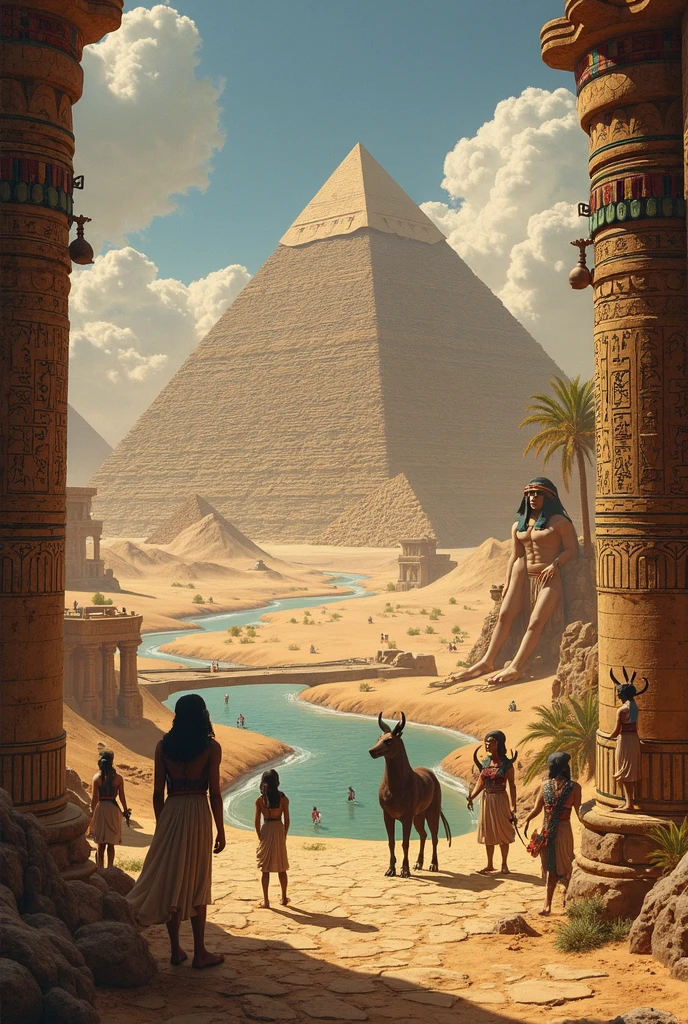Hopi Mythology: The Sacred World of Kachina Spirits
The Hopi people, indigenous to the Southwestern United States, have a rich spiritual tradition centered around the Kachina spirits. These divine beings play a crucial role in their mythology, serving as intermediaries between humans and the gods. The Kachina are believed to bring rain, ensure fertility, and protect the community from harm. Their presence is celebrated through elaborate dances, intricate masks, and sacred rituals that have been passed down for generations.
The Origins of Kachina Spirits
According to Hopi mythology, the Kachina spirits emerged from the underworld to guide and teach the people. They are considered ancestral beings who visit the Hopi villages during the first half of the year, from the winter solstice until mid-summer. Each Kachina has a distinct role, representing natural elements, animals, or moral teachings.
Types of Kachina Spirits
The Hopi recognize hundreds of Kachina spirits, each with unique attributes. Some of the most well-known include:
- Aholi – A chief Kachina who oversees ceremonies.
- Eototo – A spiritual leader associated with fertility and growth.
- Angwusnasomtaka – The Crow Mother, symbolizing wisdom and protection.
- Kokopelli – A humpbacked flute player linked to agriculture and music.
Kachina Dances and Ceremonies
The dances performed in honor of the Kachina are among the most sacred traditions of the Hopi. These ceremonies are held to invoke rain, ensure a good harvest, and maintain balance in the world. The dancers wear elaborate masks and costumes that embody the spirits they represent.
Significance of Kachina Masks
The masks used in Kachina dances are not merely decorative; they are considered sacred objects that allow the wearer to channel the spirit’s power. Made from cottonwood root and adorned with feathers, paint, and other natural materials, these masks are believed to transform the dancer into the Kachina itself.
| Kachina Type | Symbolism | Associated Ceremony |
|---|---|---|
| Hemiskatsina | Rain and fertility | Powamu (Bean Dance) |
| Mongkatsina | Warrior spirit | Niman (Home Dance) |
| Qöqöqlö | Clown and moral teacher | Various social dances |
Kachina and the Prophecies of Drought
The Hopi have long held prophecies about environmental changes, particularly concerning drought. The Kachina spirits are seen as guardians who can intervene to prevent disaster. According to tradition, if the people neglect their rituals, the Kachina may withdraw their blessings, leading to famine and hardship.
The Role of Kachina in Modern Hopi Life
Even today, the Kachina remain central to Hopi spirituality. While some ceremonies have evolved, the core beliefs endure. Many Hopi artisans continue to carve Kachina dolls, which serve as educational tools for younger generations and are highly valued by collectors worldwide.
Kachina Dolls: Sacred Art and Teaching Tools
Kachina dolls are intricately carved representations of the spirits, traditionally given to children to teach them about their culture. These dolls are not toys but sacred objects that embody the essence of the Kachina they depict.
How Kachina Dolls Are Made
The process of creating a Kachina doll involves:
- Selecting the right cottonwood root.
- Carving the figure with traditional tools.
- Painting and decorating with natural pigments.
- Adding feathers, leather, and other symbolic elements.
For further reading on Hopi traditions, visit Encyclopedia Britannica, Smithsonian Magazine, or explore the National Park Service for cultural insights.
Descubre más sobre mitología y cultura indígena en nuestra web y síguenos en facebook.com/zatiandrops.
The Hopi Creation Story: Emergence from the Underworld
Central to Hopi mythology is the story of their emergence from the underworld, known as the Sipapu. According to tradition, the Hopi ancestors journeyed through multiple worlds before reaching the Fourth World, or Tuwaqachi, where they now reside. Each world represented a stage of spiritual and moral development, with the final emergence symbolizing enlightenment and harmony with nature.
The Four Worlds of Hopi Cosmology
| World | Name | Significance |
|---|---|---|
| First World | Tokpela | A pristine but flawed existence; destroyed by fire |
| Second World | Tokpa | Corrupted by greed; collapsed into ice |
| Third World | Kuskurza | Ruined by war; flooded by the gods |
| Fourth World | Tuwaqachi | Current world, sustained through balance and ritual |
The Role of Spider Woman in Hopi Mythology
One of the most revered figures in Hopi mythology is Spider Woman (Kokyangwuti), a creator deity who shaped the first humans from clay. She taught the Hopi weaving, agriculture, and the sacred ceremonies tied to the Kachina. Her wisdom is echoed in the intricate patterns of Hopi basketry and pottery, which often depict her symbol—the spiral, representing the journey of life.
Lessons from Spider Woman
- Interconnectedness – Emphasized through her web, symbolizing the unity of all life.
- Resourcefulness – Taught the Hopi to use natural materials sustainably.
- Protection – Believed to shield the Hopi from harm during their migrations.
The Hopi Calendar and Ceremonial Cycle
The Hopi follow a lunar-solar calendar divided into two halves: the Kachina season (December–July) and the non-Kachina season (August–November). Each phase is marked by ceremonies that align with agricultural cycles and celestial events, ensuring cosmic balance.
Key Ceremonies and Their Purposes
- Soyalangwul (Winter Solstice) – Welcomes the Kachina back to the villages.
- Powamu (February) – The Bean Dance, ensuring crop fertility.
- Niman (July) – The Home Dance, bidding farewell to the Kachina as they return to the spirit world.
- Wuwuchim (November) – A new year ritual with fire and purification rites.
The Prophecy of the Blue Star Kachina
Among the most discussed Hopi prophecies is the arrival of the Blue Star Kachina (Pahana), a messianic figure who will signal the end of the current world cycle. This prophecy, tied to celestial signs and environmental collapse, warns of upheaval but also renewal if humanity returns to spiritual harmony.
Signs of the Prophecy
- Natural disasters and climate shifts.
- The disappearance of traditional knowledge.
- The reappearance of sacred artifacts.
Hopi Clans and Their Mythological Origins
The Hopi are organized into matrilineal clans, each with a unique origin story tied to the emergence myth. For example:
- Bear Clan – Descended from the first people to emerge, led by a bear spirit.
- Snake Clan – Guardians of water rituals, linked to serpent deities.
- Sun Clan – Associated with solar worship and fire ceremonies.
Clan Responsibilities
| Clan | Role | Sacred Duty |
|---|---|---|
| Kachina Clan | Ritual leaders | Organize dances and mask ceremonies |
| Corn Clan | Agricultural stewards | Oversee planting and harvest rituals |
| Fire Clan | Spiritual protectors | Maintain ceremonial fires |
Hopi Symbols and Their Meanings
Hopi art and pottery are rich with symbols derived from their mythology. Common motifs include:
- Maze (Tapuat) – Represents life’s journey and choices.
- Rain Cloud – Symbolizes blessings from the Kachina.
- Kokopelli – Embodies fertility, music, and trickster energy.
For deeper exploration, refer to Native Languages Project, Crow Canyon Archaeological Center, or Heard Museum for Hopi artifacts.
Descubre más sobre mitología y cultura indígena en nuestra web y síguenos en facebook.com/zatiandrops.
The Significance of Corn in Hopi Mythology
Corn, or maize, holds a sacred place in Hopi mythology as the literal and spiritual sustenance of the people. According to tradition, Spider Woman gave the first corn seeds to the Hopi during their emergence into the Fourth World. The plant is considered a living ancestor, with each color of corn representing different aspects of life:
- Blue Corn – Symbolizes endurance and resilience
- White Corn – Represents purity and the east direction
- Yellow Corn – Associated with the north and nourishment
- Red Corn – Connected to the south and life-giving energy
The Corn Mother Ceremony
This annual ritual honors the Corn Mother (Muingwu), the deity who ensures agricultural abundance. During the ceremony:
- Seeds are blessed with sacred cornmeal
- Prayer sticks (pahos) are planted in fields
- Traditional corn-grinding songs are performed
Hopi Star Knowledge and Astronomy
The Hopi possess sophisticated astronomical knowledge that guides their ceremonial calendar. Key celestial bodies in their mythology include:
| Celestial Body | Hopi Name | Mythological Significance |
|---|---|---|
| Polaris | Pöqangwhoya | The “nail” that fastens the sky |
| Pleiades | ChooChookam | Seven maidens who guide the seasons |
| Venus | Palaongawhoya | Messenger between worlds |
The Hopi Zodiac
Unlike Western astrology, the Hopi zodiac consists of 12 constellations that represent animal spirits and natural phenomena. These include:
- Kwaatoko (The Eagle) – Leadership and vision
- Honan (The Bear) – Healing and strength
- Paalölöqangw (The Butterfly) – Transformation
Water in Hopi Cosmology
In the arid Southwest, water is both a physical necessity and spiritual concept in Hopi mythology. The Water Serpent (Bálöölöokong) is a powerful deity who controls springs and underground rivers. Water-related rituals include:
- Páamuya (Water Prayer Ceremony)
- The construction of sacred springs (tuwanasavi)
- Offerings of cornmeal to water sources
The Hopi Water Clan
This specialized clan maintains ancient knowledge of:
- Divining underground water sources
- Constructing traditional irrigation systems
- Preserving water conservation songs
Hopi Oral Tradition and Storytelling
The oral tradition is the living vessel of Hopi mythology, with stories passed down through generations during winter months. Key narrative forms include:
| Story Type | Purpose | Example |
|---|---|---|
| Wuwutsinom | Creation stories | The Emergence Myth |
| Tuuveni | Moral lessons | Coyote and the Butterflies |
| Yayaatinom | Historical accounts | Migrations from Palatkwapi |
The Role of the Tribal Historian
Known as the Qaletaqa (Guardian), these trained storytellers:
- Memorize hundreds of stories verbatim
- Preserve clan-specific narratives
- Teach through dramatic performance
For additional resources on Hopi traditions, visit National Museum of the American Indian, Archaeology Southwest, or Indian Pueblo Cultural Center.
Descubre más sobre mitología y cultura indígena en nuestra web y síguenos en facebook.com/zatiandrops.
The Hopi Snake Dance: A Powerful Rain Ceremony
Among the most dramatic Hopi ceremonies is the Snake Dance, performed biennially by the Snake and Antelope clans. This intense ritual involves:
- Handling live rattlesnakes without fear
- Complex choreography symbolizing lightning
- Purification through cornmeal and sacred smoke
Symbolism of the Snake Dance
| Element | Meaning | Spiritual Connection |
|---|---|---|
| Snakes | Messengers to the underworld | Carry prayers for rain to the water spirits |
| Lightning | Divine energy | Represents the connection between sky and earth |
| Cornmeal | Purity | Creates sacred pathways for the spirits |
Hopi Prophecy Stones and Their Messages
The Hopi maintain ancient prophecy stones (Tuuveni) that depict their cosmological vision. These petroglyphs show:
- The path of human spiritual evolution
- Warnings about technological dependence
- The importance of maintaining balance with nature
Key Symbols on the Prophecy Stones
- Two paths – Representing material vs. spiritual choices
- Great Purification – Symbolized by a sweeping line
- Emergence – The spiral leading to higher consciousness
Hopi Basket Weaving and Its Mythological Roots
The art of basket weaving in Hopi culture traces back to Spider Woman’s teachings. Traditional designs incorporate:
| Pattern | Meaning | Mythological Origin |
|---|---|---|
| Whirling Logs | Cosmic balance | From the emergence story |
| Migration Lines | Ancestral journeys | Clan movement stories |
| Water Waves | Life sustenance | Water serpent mythology |
The Sacred Materials of Weaving
Hopi weavers use specific plants with spiritual significance:
- Yucca – For its strength and flexibility
- Rabbitbrush – Symbolizing abundance
- Sumac – Representing the colors of the directions
The Hopi Butterfly Dance: A Celebration of Transformation
This colorful ceremony honors Palhik Mana, the Butterfly Maiden, and celebrates:
- The metamorphosis of crops
- Personal spiritual growth
- The connection between humans and pollinators
Butterfly Dance Elements
| Component | Purpose | Symbolism |
|---|---|---|
| Tablita Headdresses | Represent butterfly wings | Spiritual elevation |
| Cornmeal Trails | Guide the dancers | Life’s journey |
| Turquoise Jewelry | Channel healing energy | Connection to sky |
For deeper understanding of Hopi traditions, explore Harvard Peabody Museum, Museum of Northern Arizona, or Autry Museum of the American West.
Descubre más sobre mitología y cultura indígena en nuestra web y síguenos en facebook.com/zatiandrops.
The Hopi Flute Ceremony: Music as Spiritual Communication
The Flute Ceremony is a lesser-known but vital Hopi ritual that uses sacred music to communicate with the spirit world. Performed during the Niman ceremony, this ancient practice involves:
- Hand-carved flutes made from river cane
- Special melodies that mimic natural sounds
- Precise musical intervals representing cosmic harmony
Types of Hopi Ceremonial Flutes
| Flute Type | Material | Spiritual Purpose |
|---|---|---|
| Paaqavi | Elderberry wood | Calling rain clouds |
| Kwaakwantawi | Bamboo | Healing ceremonies |
| Tuwaletswa | Eagle bone | Spirit communication |
Hopi Sand Paintings: Temporary Sacred Art
Unlike their Navajo neighbors, Hopi sand paintings are created for specific ceremonies and then ritually destroyed. These intricate designs:
- Are made with naturally colored sands and minerals
- Depict Kachina spirits and cosmic patterns
- Serve as portals for spiritual energy
Symbols in Hopi Sand Paintings
- Cloud terraces – Representing the layered sky world
- Emergence motifs – Showing the path from underworlds
- Corn stalks – Symbolizing life’s sustenance
The Hopi Warrior Society: Spiritual Protection
The Kwan (Warrior Society) plays a crucial role in Hopi spiritual life, maintaining:
| Responsibility | Ceremonial Practice | Mythological Connection |
|---|---|---|
| Village protection | Boundary rituals | Linked to warrior Kachinas |
| Spiritual defense | Night vigils | Guarding against negative energies |
| Discipline training | Physical endurance tests | Based on emergence stories |
Warrior Society Initiation
Young Hopi men undergo rigorous training that includes:
- Running to sacred sites at dawn
- Learning ancient combat prayers
- Making ceremonial weapons
Hopi Moon Calendar: Tracking Ceremonial Time
The Hopi lunar calendar divides the year into 13 moons, each governing specific activities:
- Kyaamuya (January Moon) – Purification time
- Powamuya (February Moon) – Bean planting
- Osomuya (March Moon) – First corn planting
Moon Phase Significance
| Moon Phase | Ceremonial Focus | Agricultural Activity |
|---|---|---|
| New Moon | Planning ceremonies | Soil preparation |
| Full Moon | Major rituals | Planting/harvesting |
| Waning Moon | Cleansing rites | Weeding/pruning |
For additional Hopi cultural resources, visit Sacred Texts Archive, UCSB Anthropology, or Archaeology Magazine.
Descubre más sobre mitología y cultura indígena en nuestra web y síguenos en facebook.com/zatiandrops.


